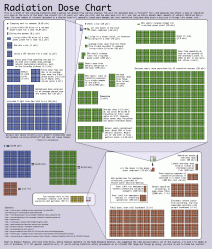|
Originally written for MLP SerfCity.US / print 201104 |
Logic of Liberty :
Lessons from Japan's Trauma
I once asked my respected tomodachi Ryu Oosake-san , whose Ampere laptop was arguably the most conceptually advanced computer of the early 1980s , whether the atomic bombing of Hiroshima and Nagasaki traumatized him as a young child . He replied "No , but being strafed by an American fighter plane did" .Tens of thousands of Japanese in future decades , when similarly asked if they were traumatized by the failures of the Fukushima daiichi reactors may well reply "No , but , after being rattled by the earthquake , my race with the Pacific Ocean relentlessly rolling in after me block after block did .
As of the end of March , there were about 12,800 known dead , and 15,000 missing , about 28,000 total ; 0 from Fukushima #1 .
I've been pleasantly surprised by the lack of alarmism by the MSM , and indeed the blogsphere . While there was the inevitable reactions from the most reality-impaired eco-statists that Global Warming caused it , the Guardian's George Monbiot posted the reasonable How the Fukushima disaster taught me to stop worrying and embrace nuclear power :
A crappy old plant with inadequate safety features was hit by a monster earthquake and a vast tsunami. The electricity supply failed, knocking out the cooling system. The reactors began to explode and melt down. The disaster exposed a familiar legacy of poor design and corner-cutting . Yet, as far as we know, no one has yet received a lethal dose of radiation.Perhaps Japan's experience with radiation dosage dependence made them more complacent about the risks of low level radiation . Certainly the antique design was never appropriately upgraded for a location subject to millennial magnitude flash floods . But the needed fixes all appear rather straight forward . And people are more aware that windmills and sun collectors won't run factories or server clouds .

Like arsenic , radioactive elements are ambient -- in widely varying concentrations . Unlike arsenic , radioactive elements have a finite half life . They break down into simpler elements releasing , of particular concern , fast particles and short wavelength photons . Luboš Motl , nuclear physicist and fellow climate realist , gives a succinct but deep explanation of the nature and measurement of radioactivity. One of the most dangerous isotopes , iodine-131 , has a half life of about 8 days so it's already almost totally turned into stable xenon . Another excellent link is a great Radiation Dose Chart working all the way from the radiation exposure of sleeping next to someone up to ten minutes next to Chernobyl's core after the explosion . Luboš calculates that there were "genuinely dangerous doses for the people who work" around the worst of the reactors .
For a lot of Japan , its going to be kind of like in the US in the '50s and '60s when the US and CCCP and France and the UK exploded hundreds of nuclear fission bombs in the atmosphere . I don't remember doing any "duck and cover" under my school desk , but I sure remember the worry over rising strontium 90 levels in the milk .
I haven't seen any convincing evidence of hormesis , the possibility that low level exposures may act as "vaccination" against later problems , but it's rather clear that levels below those closest to the plant will not have a measurable effect on longevity . The total number of deaths from Chernobyl appears to have been well less than 100 .
After the horrendous waste of enough billions taken by the War on CO2 fraudsters to contribute to the West's debt debacle , most people have come to realize that wind and solar have limited economically useful niches . They cannot power factories and call centers . Oil and gas are uniquely transportable . Petroleum is far and away the most energy-dense fuel you can pour in a tank . The taken-money masters , on the same Global Warming fraud , have inadvertently demonstrated that the highest and best use of productive agricultural land is creating food for humans , not machinery . Natural gas is just about as distributable as electricity , but intrinsically far more efficient for heating , whether residential or industrial . A fundamental law of electric circuits is , that because current must be constant all the way around a circuit , only half the power of a generator can be consumed by the load . Every time you make some toast , an equal amount of heat must be dissipated at the power station and along the power lines .
Thus for generation of electricity , other than hydro where available , the competition is between coal and nuclear . Both are abundant . It happens that which makes more economic sense depends largely on the transportation costs for the coal and electricity . Here along the Front Range of Colorado , there's a continuous stream of mile long coal trains bringing coal from Wyoming to regional power plants . Alternatively , it is not uncommon in recent decades for powerplants to be built at major coal mines , and the electricity transported from there .
But a great deal of the cost of nuclear is artificial . It was created by the eco-statists before they executed their squeeze play fomenting fear of the element which defines organic .
The stupidest of these fears is the spent fuel boondoggle . There are eight nuclear submarines lying in unchosen locations around the oceans which demonstrate the most obvious solution . Just drop the encased vitrified waste into an ocean trench . It will be an absolutely insignificant addition . They actually did that back in more rational days . But even that is unnecessarily complicated . Most of the world finds plenty of space to simply bury it on site . In the US , there's also a radioactive waste and decommissioning company which operates its own Yucca Mountain which which apparently got canceled ( after billions spent ) to get Harry Reid reelected . Having spent a number of hours hitchhiking at a T intersection in the desert south of Moab Utah around 1970 in the general region of a lot of the uranium mines , I have never seen any reason why the spent fuel couldn't just be dumped back in the holes it was taken out of . It contains less energy than it did when it was dug up . One reason France , for example , has no problem storing its waste on site is that they reprocess their spent fuel reducing the waste by 95% . But that was prohibited in the US back in Carter and 3-mile Island days ..
Among information discussed on a Heartland Institute conference call on this issue , was the comment that "you can walk away from" current generation 4 designs . The South Africans apparently have a very stable fuel pebble design . The Fukushima reactors are generation 2 with "the worst kind of Japanese bureaucracy" . Among the new designs are ones 250 megawatt railroad car size modulars . That's the 24/7 equivalent of the rated power of more than 100 wind turbines .
I am interested to see that Singapore is considering an I idea that occurred to me some years ago : just build the reactor deep underground to begin with . Minimal space and nothing to clean up .
So , the future of nuclear power looks very solid . The economics , which means human welfare , are too compelling for any government truly concerned about its citizens' standard of living to ignore . A number of countries are demonstrating that State commanded wind and solar are a path to sovereign bankruptcy .
To close on a cautionary note , the physical plant may be as stable as can be , but see Ralph Langner's TED talk on the apparent cyber attack on Iran's nuclear program , presumably by Israel and US .
---
A few additional links :
Lawrence Solomon: Japan’s radioactive fallout could have silver lining
http://www.reuters.com/article/2011/03/30/us-japan-quake-idUSTRE72A0SS20110330?feedType=nl&feedName=ustopnewsearly
http://www.upi.com/Top_News/World-News/2011/04/06/Japan-reviews-radiation-exposure-levels/UPI-33091302089001/
http://news.yahoo.com/s/ap/20110324/ap_on_sc/us_sci_nuclear_perceptions
| Ampere laptop | http://www.cosy.com/language/cosyhard/cosyhard.htm |
| Global Warming caused it | http://www.grist.org/climate-change/2011-03-11-todays-tsunami-this-is-what-climate-change-looks-like |
| Guardian's George Monbiot | http://www.guardian.co.uk/profile/georgemonbiot |
| How the Fukushima disaster taught me to stop worrying and embrace nuclear power | http://www.monbiot.com/2011/03/21/going-critical/ |
| radiation dosage dependence | http://probeinternational.org/library/wp-content/uploads/2011/03/MineIR10-JpSurvMort1.pdf |
| Radiation Dose Chart | http://xkcd.com/radiation/ |
| the nature and measurement of radioactivity | http://motls.blogspot.com/2011/03/radioactivity-sieverts-and-other-units.html?spref=fb |
| Radiation Dose Chart | http://xkcd.com/radiation/ |
| US and CCCP and France and the UK exploded hundreds | http://en.wikipedia.org/wiki/Nuclear_weapons_testing |
| hormesis | http://en.wikipedia.org/wiki/Hormesis |
| deaths from Chernobyl | http://www.timesonline.co.uk/tol/news/world/europe/article563041.ece |
| Did the Atom Bomb Test Fallout Cause Cancer? | http://www.huffingtonpost.com/samuel-s-epstein/atomic-bomb-did-the-atom_b_797822.html |
| |
http://motls.blogspot.com/2011/03/radioactivity-sieverts-and-other-units.html?spref=fb |
| http://news.yahoo.com/s/ap/20110324/ap_on_sc/us_sci_nuclear_perceptions | http://news.yahoo.com/s/ap/20110324/ap_on_sc/us_sci_nuclear_perceptions |
| http://www.reuters.com/article/2011/03/30/us-japan-quake-idUSTRE72A0SS20110330 | http://www.reuters.com/article/2011/03/30/us-japan-quake-idUSTRE72A0SS20110330 |
|
http://www.upi.com/Top_News/World-News/2011/04/06/Japan-reviews-radiation-exposure-levels/ UPI-33091302089001/ |
http://www.upi.com/Top_News/World-News/2011/04/06/Japan-reviews-radiation-exposure-levels/ UPI-33091302089001/ |
| Pass the Plutonium | http://spectator.org/archives/2011/04/01/pass-the-plutonium |
| William Tucker | http://spectator.org/people/william-tucker |
| http://en.wikipedia.org/wiki/List_of_countries_by_uranium_reserves | http://en.wikipedia.org/wiki/List_of_countries_by_uranium_reserves |
| Uranium reserves | http://www.world-nuclear.org/info/inf75.html |
| Lawrence Solomon: Japan’s radioactive fallout could have silver lining | http://opinion.financialpost.com/2011/03/21/lawrence-solomon-reactor-victims-will-benefit-studies-show/ |
 |
|
||||
